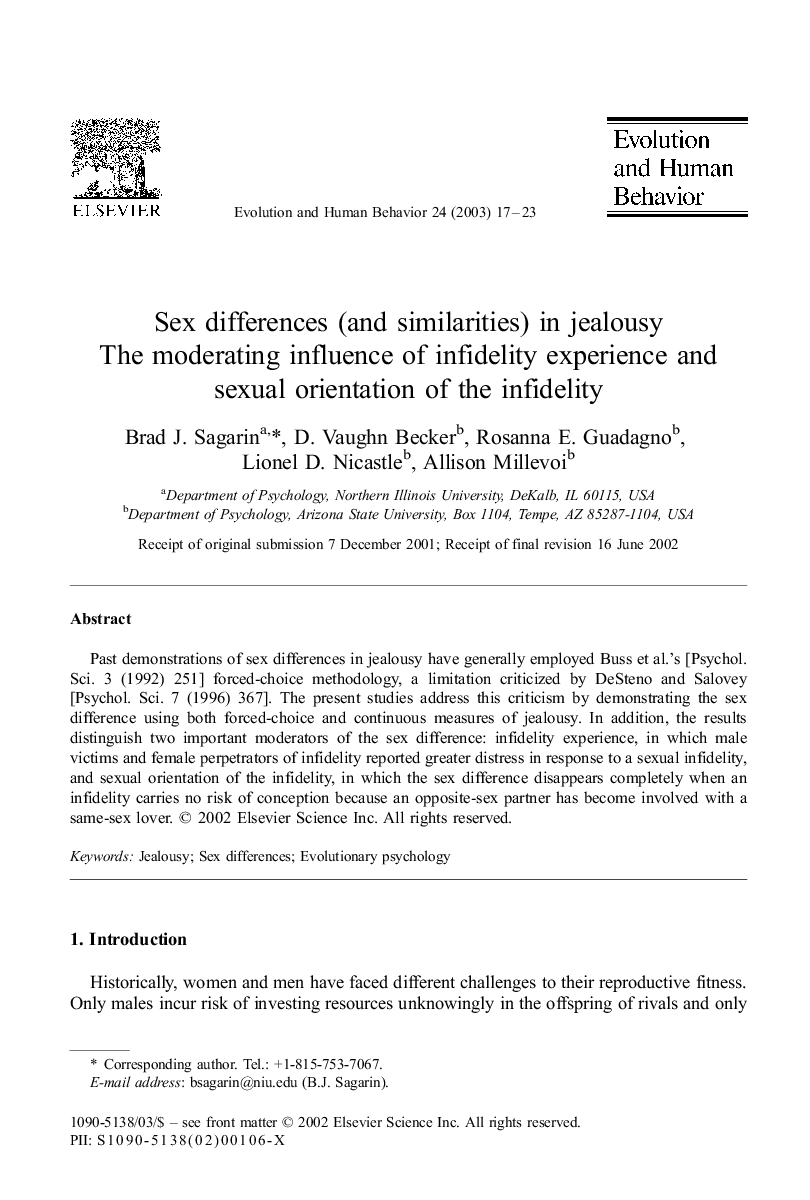Past demonstrations of sex differences in jealousy have generally employed Buss et al.'s [Psychol. Sci. 3 (1992) 251] forced-choice methodology, a limitation criticized by DeSteno and Salovey [Psychol. Sci. 7 (1996) 367]. The present studies address this criticism by demonstrating the sex difference using both forced-choice and continuous measures of jealousy. In addition, the results distinguish two important moderators of the sex difference: infidelity experience, in which male victims and female perpetrators of infidelity reported greater distress in response to a sexual infidelity, and sexual orientation of the infidelity, in which the sex difference disappears completely when an infidelity carries no risk of conception because an opposite-sex partner has become involved with a same-sex lover.
Historically, women and men have faced different challenges to their reproductive fitness. Only males incur risk of investing resources unknowingly in the offspring of rivals and only females are obliged to make substantial post-zygotic investments before a conception can yield fitness benefits. Thus, ensuring that putative offspring are indeed one's own is an adaptive challenge for males, whereas a female faces the different challenge of ensuring that the father invests resources into her children rather than those of rivals. These considerations suggest that male and female sexual jealousy will be qualitatively different Daly et al., 1982 and Symons, 1979.
Accordingly, Buss, Larsen, Westen, and Semmelroth (1992) predicted that men and women would differ in their responses to emotional and sexual infidelity, with women being relatively responsive to the former and men to the latter. Both survey and physiological evidence supported this hypothesis: when asked which type of infidelity would distress them more, men were much more likely than women to select the sexual infidelity, and when subjects were instructed to fantasize about one type of infidelity or the other, measures of electrodermal activity and heart rate supported the conclusion that the sexes differed in the two types of infidelity's relative emotional impacts.
DeSteno and Salovey (1996, p. 371) have argued that these findings have limited generality, concluding “Although the sex difference in infidelity choice reported by Buss et al. (1992) is readily replicable using the forced-choice paradigm, we have been unable to replicate it using continuous measures asking individuals to rate the amount of distress experienced in response to each type of infidelity. Failures to find this effect using both manifest and latent multiple measures of jealousy led us to question the robustness of the originally reported sex difference outside of the forced-choice paradigm.” The present studies address this criticism by asking participants to indicate their reactions to infidelities using both forced-choice and continuous measures (see Geary, Rumsey, Bow-Thomas, & Hoard, 1995, for a prior use of a continuous measure of jealousy, and Pietrzak, Laird, Stevens, & Thompson, 2002, for a recent demonstration of sex differences using continuous measures).
In addition, because sex differences in jealousy are theorized to stem from differential threats to ancestral male and female reproductive fitness, they may disappear in response to “infidelities” in which reproduction is clearly impossible, namely cases in which an opposite-sex partner becomes involved with a same-sex lover. A same-sex infidelity does not entail the asymmetrical threats of mistaken paternity and of resources being diverted to another woman's children, suggesting both that the sexes may be similar in their jealous responses and that such responses may be less intense than in the case of opposite-sex infidelities.
Is it reasonable to expect evolved emotional responses to infidelity to be modulated in this way? Two considerations suggest that it may be. First, bisexual behavior is sufficiently well documented both historically and cross-culturally Cantarella, 1992, Dynes & Donaldson, 1992a and Dynes & Donaldson, 1992b to indicate that responding appropriately to same-sex infidelities is a challenge with a long history. Secondly, same-sex sexual interactions are sufficiently widespread in other animals, including other primates (Bagemihl, 1999), to suggest that responding differentially to the homosexual versus heterosexual behavior of others is an ancient adaptive problem. Furthermore, since jealousy is a dangerous emotion, with potentially dire ramifications for all concerned (Buss, 1999), it would be reproductively advantageous to feel intense jealousy specifically when one's reproductive outcomes are at risk. Thus, we predict that men and women will differ in their responses to sexual and emotional infidelities with opposite-sex partners, but not with same-sex partners, and that jealousy will be significantly less intense in the latter case than in the former.


